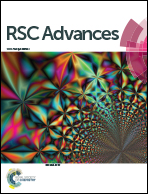Comparative study between microwave and ultrasonication aided in situ transesterification of microbial lipids
Abstract
Recent trends have focused on the development of a rapid method to convert microbial lipids to biodiesel. In situ transesterification allowed minimizing the requirement of solvents by combining the two steps (extraction of lipid and conversion to biodiesel) to a single step. Box–Behnken design was used for optimization of the variables to optimize the biodiesel yield and conversion. Microwave and ultrasonication assisted in situ transesterification methods were compared based on the conversion efficiencies and their performance. A microwave approach revealed that around 99 ± 0.5% of conversion of FAMEs (w lipid conversion/w total lipids) was obtained in the presence of a methanol to lipid molar ratio above 183 : 1 and NaOH addition of 2% (w/w) lipid in 20 min at 100 °C. Meanwhile, the ultrasonication yielded around 95.1 ± 0.2% (w/w total lipids) in the presence of a methanol to lipid molar ratio of 183 : 1 and NaOH addition of 3% (w/w) lipid in 20 min at 25 °C. The final profile of FAMEs was fully compatible with that of the conventional process based on chloroform and methanol extraction and required 12 hours for extraction.


 Please wait while we load your content...
Please wait while we load your content...